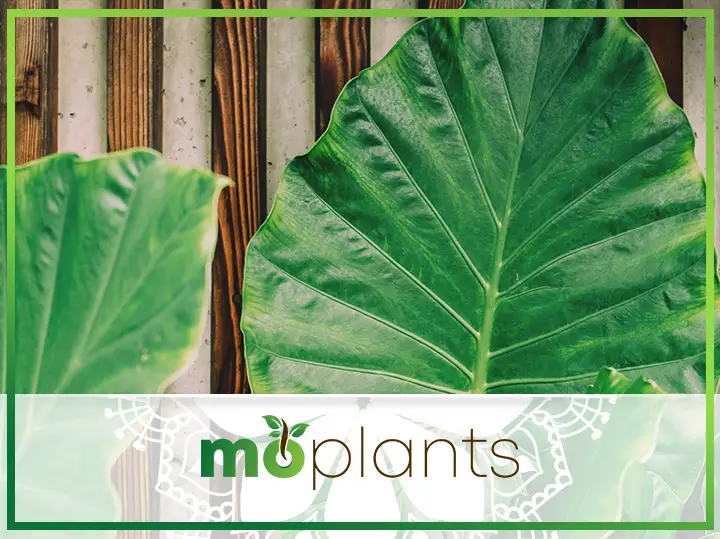The dramatic appearance and vibrant foliage of elephant ear plants can turn your home garden into a luscious tropical paradise. These exotic plants get their unique name from their oversized heart-shaped leaves reminiscent of elephant ears. They are bold, beautiful and produce clusters of colorful berries following the bloom.
Interestingly, these impressive plants used to enjoy widespread popularity during the Victorian era before eventually falling out of favor. However, their eccentric appearance and eye-catching color have once again made them a favorite among interior designers who utilize the sheer size of their leaves to create show-stopping centerpieces.
The elephant ear plants are native to the tropical regions in Asia, Australia, Central America, South America, and Africa. You can find them in a variety of hues ranging from deep emerald green to dark purple and gorgeous chartreuse gold. Some plants also feature mesmerizing variegations, adding to their aesthetic appeal.
You will also be glad to know that you can grow these iconic plants indoors and outdoors alike. While they thrive outdoors in the warmer areas, you can also consider growing elephant ears in large containers to transform your living room into a cozy jungle. Meanwhile, if you plan on growing these gigantic plants in your backyard, planting them alongside bananas, coleus, and cannas will make your space look like a tropical oasis.
Here is everything you should know about elephant ears and how to make them the focal point of your plant collection.
Introduction: Elephant Ear Plant
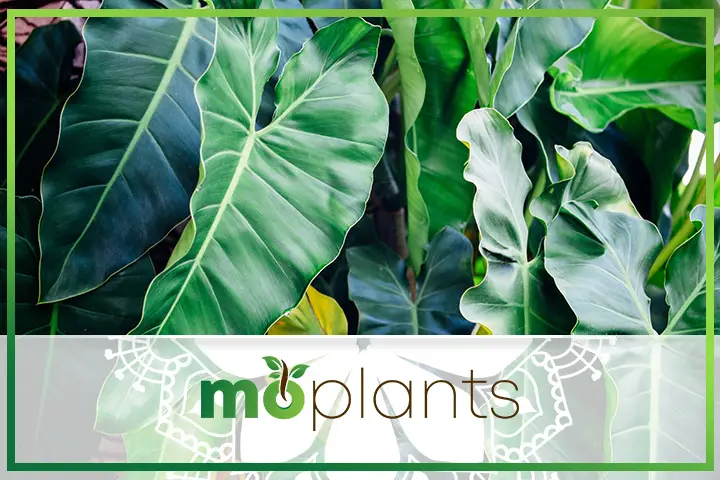
The botanical name of the elephant ear is Colocasia esculenta, also known as the taro plant or coco yam. It belongs to the Araceae family in the genus Colocasia. However, the term “elephant ears” is also commonly used for large tropical perennials in the Alocasia and Xanthosoma genera.
These eye-catching plants are fast growers, with some varieties achieving their full size in as little as two months. The mature size of elephant ears ranges from three to nine feet tall with a similar width in warmer climates. Meanwhile, their leaves can grow up to three feet long and two feet wide with prominent veins adorning their surface.
Most home gardeners and interior decorators prefer elephant ear plants due to their bold foliage instead of tube-shaped flowers that produce a cluster of red, yellow, or orange berries. Interestingly, most people end up snipping off the bloom to ensure the rest of the plant receives proper nutrition.
The ornamental appearance of the elephant ear leaves makes them the perfect accent plant for every home décor style. Moreover, the plant thrives in warm and humid climates. So, if you live in USDA hardiness zones 8 to 11, you can grow these plants throughout the year. However, those who reside in colder areas can either discard the lush green plant at the end of the season or store it indoors for planting once the winter is over.
The species of elephant ears in the Colocasia genus grow from tuberous roots, whereas the large plants in the Alocasia and Xanthosoma genera grow from a hard swollen stem structure known as a corm. Additionally, like most other tropical plants, elephant ears don’t require excessive care to flourish. As long as you provide them with adequate water and warmth, these magnificent plants will continue to add a burst of color and freshness to your space.
NOTE: Florida, California, Alabama, and South Carolina, among other states, have listed Colocasia esculenta as an invasive species. It is an aggressive invader that can grow easily in wetlands and swamps while blocking the sunlight and absorbing the nutrients of other vegetation.
How to Grow Elephant Ears
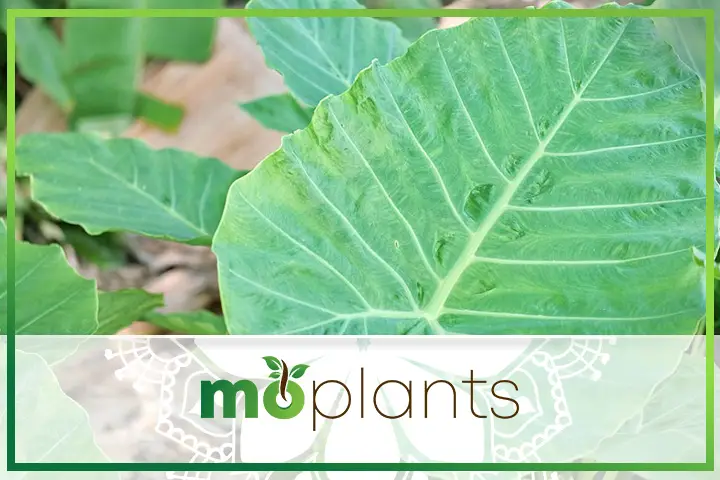
Here are some tips on growing elephant ears that can help you showcase your gardening skills to everyone who sets foot in your home.
Planting and Placement
The best time to plant elephant ears is in mid-spring or early summer. These exotic beauties are not cold-hardy and are not likely to survive in frost. Therefore, if you want to see these charming plants add to the aesthetic appeal of your space, please make sure to only plant them once the temperatures have reached 65 degrees Fahrenheit.
Moreover, it is ideal for placing elephant ears in a location that receives partial or full sun. After all, these plants can make alluring additions to your patio, terrace, balcony, and backyard. Nonetheless, if you want to grow them indoors, consider placing the container near an open window where the foliage can receive bright and indirect light.

Exposure to Sunlight
As mentioned above, elephant ears do well in full sun to partial shade. For the best results, consider placing them in an area with spotty shade where they will be protected from strong gusts of wind.
Fun Fact: Darker cultivars of elephant ears do well in partial shade, while the lighter varieties require full light.
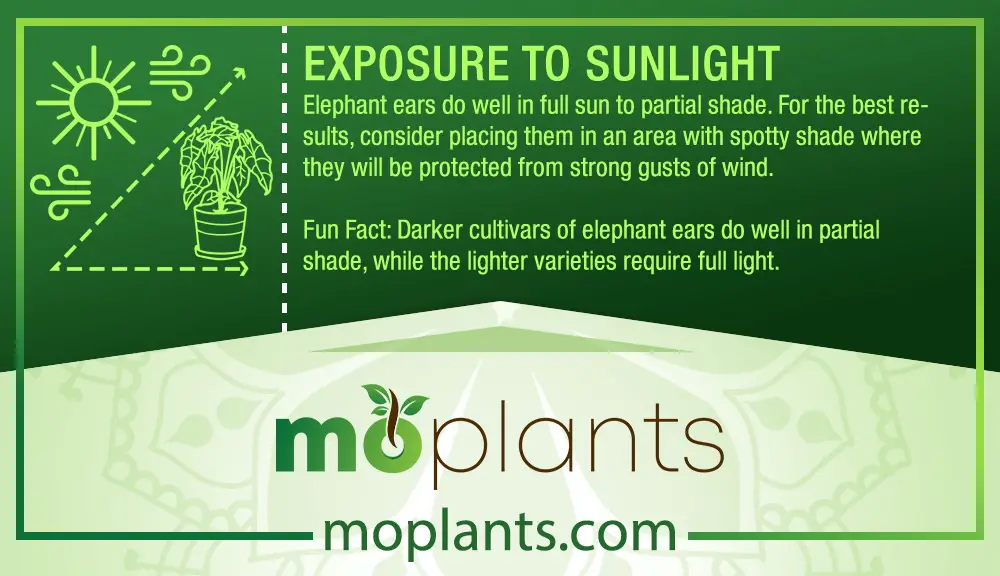
Watering Frequency
Elephant ear plants need frequent watering. On average, you should consider adding two to three inches of water to your plant every week. Some plant varieties also thrive in several inches of standing water, though doing so is never recommended as it might result in root rot.
It is ideal for keeping the soil of your elephant ear plant moist at all times. If the soil feels dry to touch, please make sure to water it thoroughly. Moreover, plants that grow in containers typically require more water than those that grow in the ground.
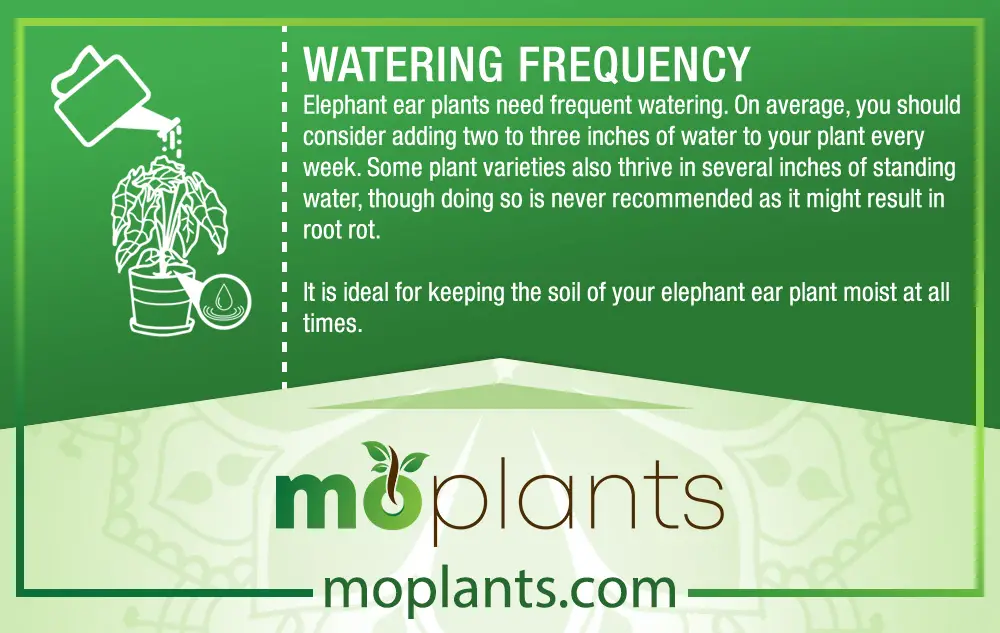
Potting Mix
Acidic soil with a pH level ranging between 5.5 and 7.7 will do wonders for your elephant ear plants. You can choose a rich organic potting mix for your plant and enhance it with peat and perlite to recreate the environment of a natural wetland. It is generally a good idea to use well-drained soil free of any rocks for growing elephant ears.
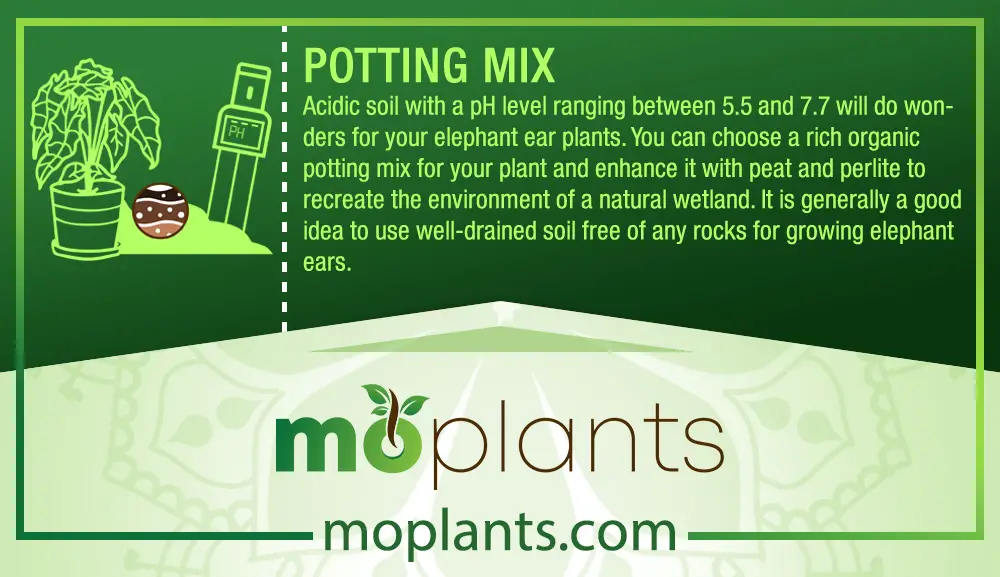
Infographic
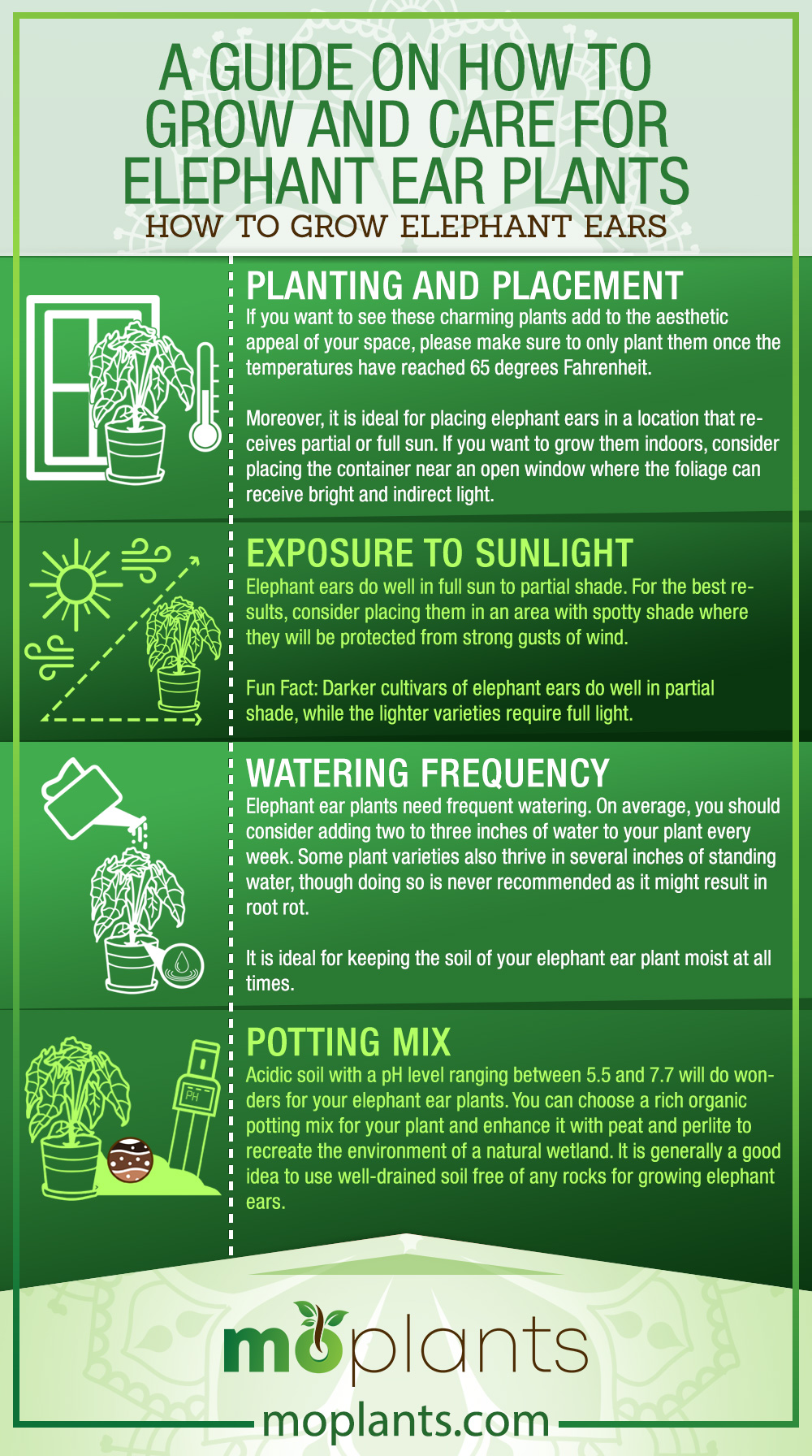
Elephant Ear Propagation Method
The two main elephant ear propagation methods include:
- Propagation by seed
- Propagation by division
If you are thinking about growing elephant ears from seeds, you will have to spread them on a seed starter tray and moisten the surface with plain water spray. Next, place the tray in a warm location that receives indirect light. It would be best to take extra care to ensure the seed starting mix is always moist until tiny plants begin to sprout. Depending on the cultivar and climate, the entire process can take as quick as three weeks or as long as three months.
Alternatively, you can propagate elephant ears by division in late summer or early fall. To multiply your mesmerizing plants, dig up the corms of the tuber of the planted species and carefully divide them into smaller parts, each with its growth node attached. Please wear protective gloves, and don’t forget to sterilize your knife before cutting through the plant.
Next, leave the cut part of the plant to dry and scab over before covering it with paper and storing it for planting in the next season. However, if you live in a warm region, you can plant the divided pieces into a large container with growth nodes facing upwards. Make sure to space the plants at least two to four feet apart and only bury them about five inches deep.
Soon enough, your elephant ear plant will begin to grow in its container or the ground.
Elephant Ear Care Tips
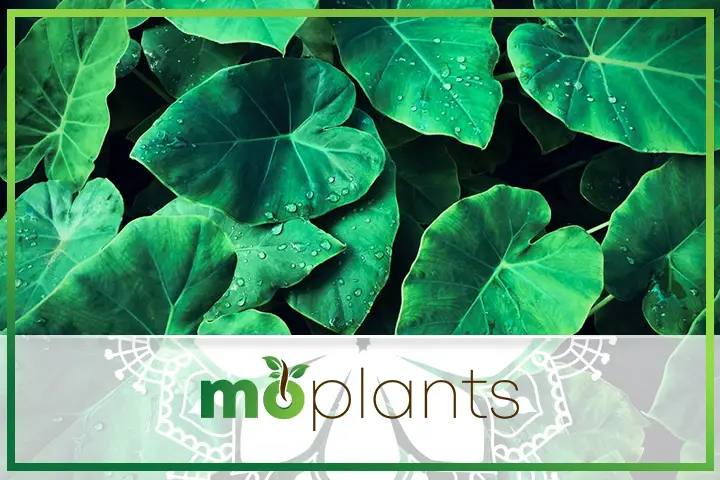
Follow these elephant ear care tips to keep its foliage healthy and beautiful throughout the growing season.
Temperature
Since they are native to tropical regions, elephant ears prefer warm temperatures ranging between 70 and 80 degrees Fahrenheit during the day and around 65 degrees Fahrenheit at night. Once the temperature drops to 55 degrees Fahrenheit or lower, you may want to bring your plant indoors.
Humidity
Elephant ears love humid environments. Hence, if you live in a relatively dry climate, consider misting the large leaves every two days to keep them hydrated. You can also place the container on top of a pebbles tray filled with water. When the moisture evaporates, it will hydrate the plant and increase humidity.
Alternatively, you can invest in a humidifier to ensure the foliage remains glossy and glistening.
Pruning
Removing dead leaves regularly is essential for healthy foliage. You can use sharp and sterilized pruning shears to eliminate brown leaves by cutting the stem about two inches from the ground.
It would be best to make clean and straight cuts to encourage new growth.
Fertilizing
Elephant ear plants are heavy feeders. Usually, applying a water-soluble high-nitrogen fertilizer is enough to sustain a plant for about three weeks. If required, you can buy a slightly stronger fertilizer from a nearby garden center.
Infographic
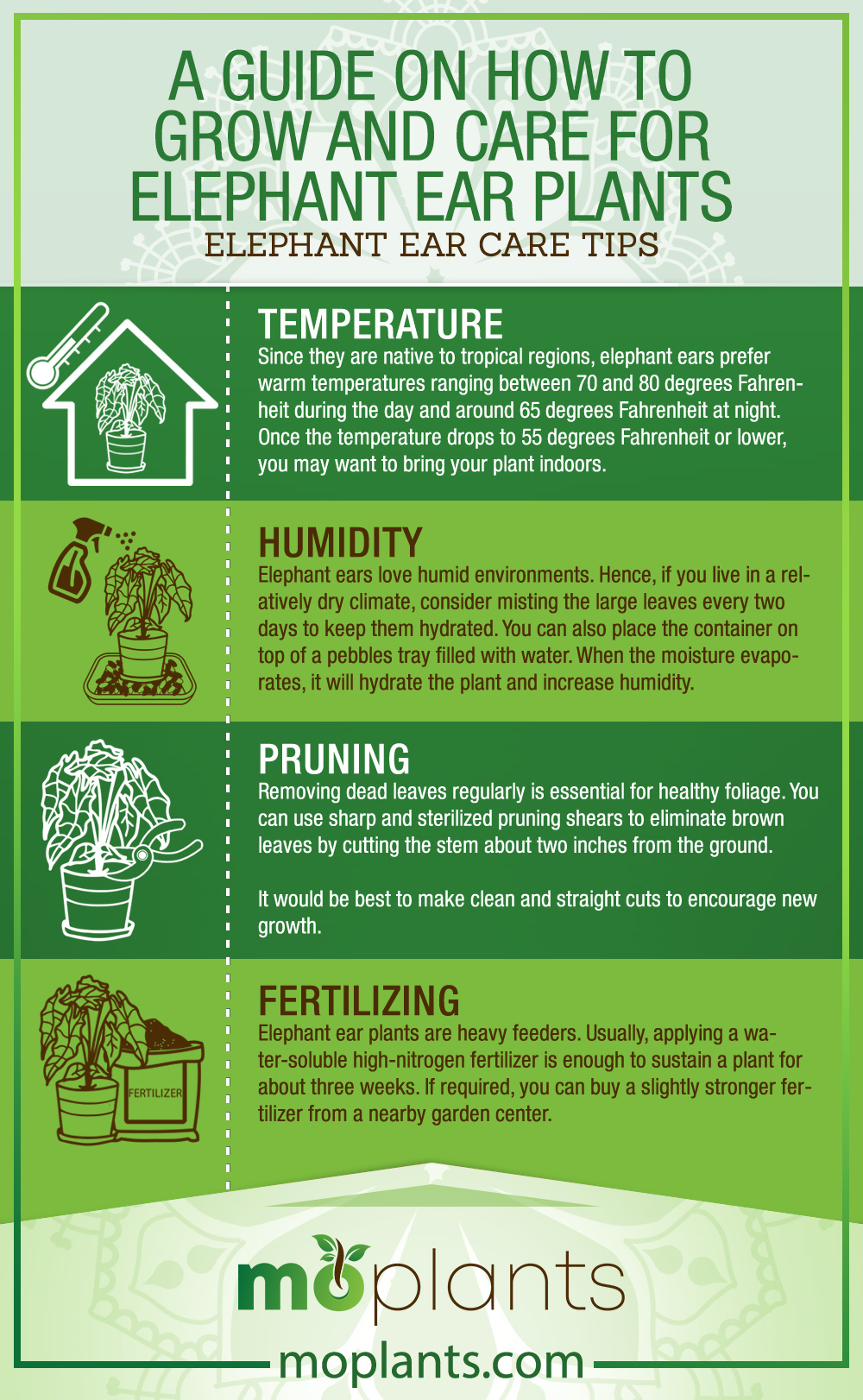
Common Elephant Ear Problems and How to Solve Them
Let’s look at tips on how to troubleshoot some of the most common elephant ear issues.
Yellowing Leaves
If your plant’s leaves are turning yellow, it could indicate a lack of light or fertilizer. Depending on the weather, you can consider placing your elephant ears in a sunnier location or treating them to rich organic matter. Underwatering could also be the culprit behind yellowing leaves, so don’t forget to water your plant adequately.
Smaller Leaves
The elephant ear leaves don’t grow to their full size in cold climates. However, if you live in USDA zones 8 to 11, you can consider providing your plant with more fertilizer and water to ensure it receives adequate nutrients to grow.
Wilting Leaves
This iconic plant thrives in full sun, but excessive heat can be detrimental to its foliage.
Therefore, if your plant’s leaves are beginning to wilt, it may be time to move it to a location with dappled shade. Moreover, consider watering it more frequently so the foliage can quickly bounce back to its former glory.
Common Pests and Diseases
Elephant ears can be vulnerable to aphids, scales, and mites. If you notice any bugs munching on the edges of your leaves, please make sure to wash them with horticultural soap immediately.
Meanwhile, if you can see a fuzzy growth on the foliage or a yellowish fluid oozing from different spots on the plant, it may be infected with the fungal leaf blight. The best way to treat this problem is to separate the infected plant from the rest and remove the affected leaves as soon as possible.
Are Elephant Ears Toxic?
Unfortunately, elephant ears can be highly toxic to humans and animals alike. Touching their leaves and stems can often result in skin irritation and rashes. The sap present in the plant is also very poisonous. Therefore, you should be extra vigilant while handling it.
Ingesting a large amount of these leaves can be extremely harmful. So, if you fear your child or pet has taken a few bites of this plant, please make sure to contact a physician or vet immediately.
Symptoms of Elephant Ear Poisoning
Let’s look at some of the most common symptoms of elephant ear poisoning among cats and dogs.
- Oral irritation
- Skin irritation
- Pawing at the face and mouth
- Swelling of mouth and tongue
- Foaming
- Vomiting
- Trouble breathing
- Difficulty swallowing
Popular Types of Elephant Ear Plants
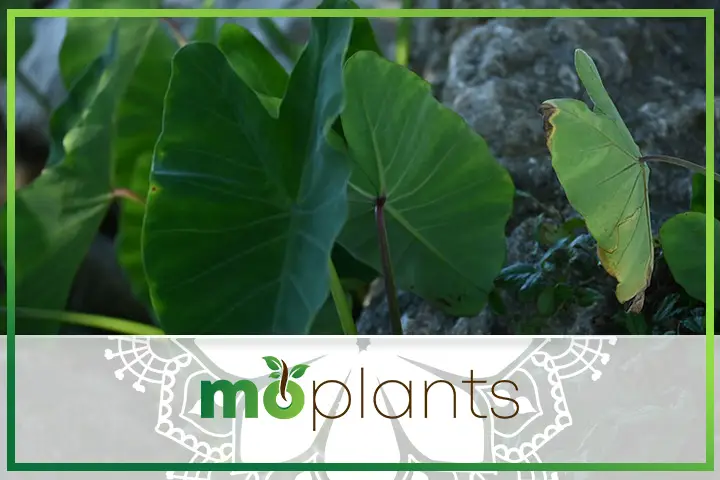
Did you know there are nearly 200 cultivars of elephant ears? Check out some of the most well-known varieties of these tropical plants.
Colocasia esculenta Black Magic
The dusky purple and black leaves of this elephant ear cultivar make it one of the most charming plants you can grow in your home. The bold hues and slightly upward folding foliage give Colocasia esculenta Black Magic an eccentric appearance.
It can grow up to five feet tall in an average indoor or outdoor environment.
Colocasia esculenta Hawaiian Punch
It is a relatively new cultivar from Hawaii that instantly became a fan favorite due to its bright green leaves featuring deep red veins. The stems of this plant also have a reddish hue, adding to its ethereal beauty. However, Colocasia esculenta Hawaiian Punch is relatively compact and only grows as tall as three feet.
Colocasia esculenta Diamond Head
The burgundy -colored and heart-shaped ruffled Colocasia esculenta Diamond Head leaves can make this plant the center of attention in any home. The spectacular leaves are supported by thick stalks and feature a shiny surface that looks like something right out of a fairytale.
In addition, this plant prefers full sun and can grow as tall as four feet with two-foot-wide leaves.
Elephant Ear FAQs
These are some of the most frequently asked questions about growing elephant ears.
Are elephant ears poisonous to touch?
The sap in the leaves and stems of elephant ears contains calcium oxalate crystals. If it comes in contact with your skin, the sap can cause severe irritation.
Do elephant ear plants require a lot of water?
Elephant ears are tropical plants and need a lot of water to live. You can water them thoroughly once a week during the summer months and then reduce the amount of water as the weather gets colder.
Can elephant ears survive indoors?
Yes, you can grow almost all elephant ear cultivars as houseplants. However, you will have to invest in large containers to ensure your plants have enough room to grow.
To conclude, elephant ears are fast-growing tropical plants with long stems and enormous leaves. They look particularly stately and would thus make a wonderful addition to any home garden or indoor collection, provided you live in a warm and humid environment. Some elephant ears are considered invasive species, so please make sure to check with the local authorities before introducing this plant to your backyard.

